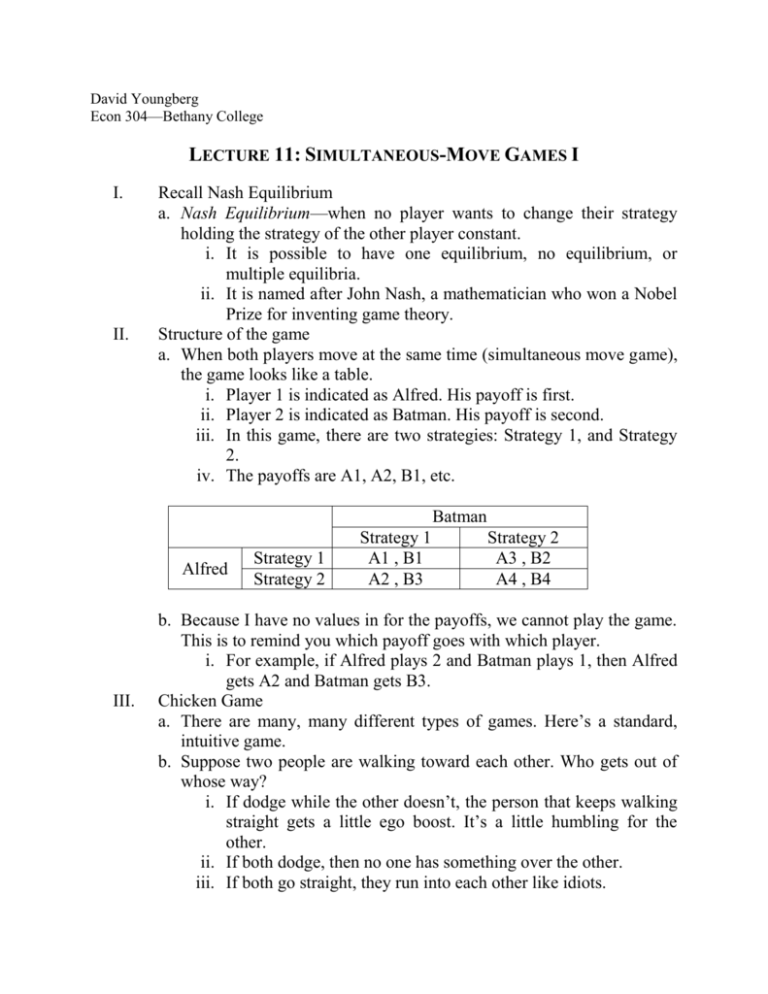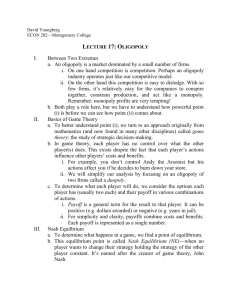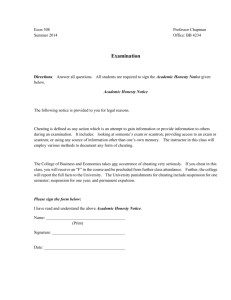02/27 - David Youngberg
advertisement

David Youngberg Econ 304—Bethany College LECTURE 11: SIMULTANEOUS-MOVE GAMES I I. II. Recall Nash Equilibrium a. Nash Equilibrium—when no player wants to change their strategy holding the strategy of the other player constant. i. It is possible to have one equilibrium, no equilibrium, or multiple equilibria. ii. It is named after John Nash, a mathematician who won a Nobel Prize for inventing game theory. Structure of the game a. When both players move at the same time (simultaneous move game), the game looks like a table. i. Player 1 is indicated as Alfred. His payoff is first. ii. Player 2 is indicated as Batman. His payoff is second. iii. In this game, there are two strategies: Strategy 1, and Strategy 2. iv. The payoffs are A1, A2, B1, etc. Batman Alfred III. Strategy 1 Strategy 2 Strategy 1 A1 , B1 A2 , B3 Strategy 2 A3 , B2 A4 , B4 b. Because I have no values in for the payoffs, we cannot play the game. This is to remind you which payoff goes with which player. i. For example, if Alfred plays 2 and Batman plays 1, then Alfred gets A2 and Batman gets B3. Chicken Game a. There are many, many different types of games. Here’s a standard, intuitive game. b. Suppose two people are walking toward each other. Who gets out of whose way? i. If dodge while the other doesn’t, the person that keeps walking straight gets a little ego boost. It’s a little humbling for the other. ii. If both dodge, then no one has something over the other. iii. If both go straight, they run into each other like idiots. c. I assign payoff to reflect these realities. The actual value doesn’t matter; only the relative value. Batman Alfred IV. Dodge Straight Dodge 0,0 1 , -1 Straight -1 , 1 -3 , -3 i. Where is Nash Equilibrium? ii. One way to find it is by cell-by-cell inspection. For each resulting pair of strategies, ask if either person would like to change their behavior. Continue until all cells are inspected. iii. At Dodge, Dodge, Alfred would like to change to Straight, holding Batman’s Dodge choice constant. We know this because a payoff of 1 is greater than 0. Ben feels the same way. iv. At Straight, Straight, Alfred would like to change to Dodge, holding Batman’s Straight choice constant. We know this because a payoff of -1 is greater than -3. v. At Dodge, Straight and Straight, Dodge, neither is willing to unilaterally change their behavior. Both are Nash Equilibria. vi. Note that in practice, this is often what happens. The Prisoner’s Dilemma a. Imagine Bonnie and Clyde rob a bank and kill someone during their escape. Thanks to cameras, the police have enough evidence for robbing the bank, but because the murder took place in a nearby alley, they lack the evidence to convict them on murder. b. They clearly want to get them on both so they put them in separate rooms and ask them to either confess or deny to the murder. i. If they both deny the murder, the police must arrest them for only the lesser charge; they don’t have enough evidence otherwise. ii. If one denies while the other confesses, the confessor gets a deal and the denier gets time for not just robbing the bank and murder but also lying to the police. iii. If the both confess, Bonnie and Clyde get time for the bank robbery and the murder. Bonnie Clyde V. Deny Confess Deny -2 , -2 -1 , -5 Confess -5 , -1 -4 , -4 c. In this game, there is only one Nash Equilibrium. It is also the worst result (the highest total number of years in prison). d. The Prisoner’s Dilemma plays out in many different scenarios. i. Arms races ii. Cartels iii. Tragedy of the commons iv. War rather than trade Strategies a. The reason why the Prisoner’s Dilemma is so hard to get out of is that its Nash Equilibrium is made up of dominant strategies. i. Dominant Strategy—a strategy which outperforms all other strategies regardless of the other player’s strategy. Note it is independent of the other players’ payoffs. ii. Strictly Dominant Strategy—a strategy which always produces a higher payoff. iii. Weakly Dominant Strategy—a strategy which always produces a higher or equal-to payoff. iv. Dominated Strategy—a strategy which always produces a less preferred result than another strategy. b. Because Confess is always the strictly dominant strategy, getting out of the prisoner’s dilemma is really hard. But there are ways: repeat the game, reward and punishment, and add leadership. c. We can use dominate strategies to find Nash equilibrium, since cellby-cell inspection becomes difficult if there are many different cells. Being able to eliminated a dominated strategy is very valuable here. d. Some collieries of strategy definitions: i. No player can have more than one strictly dominate strategy. ii. If each player has one strictly dominate strategy, then there is exactly one Nash equilibrium. iii. If each player’s strategies are weakly dominate, then all possibilities are Nash equilibrium (because each person gets the same payoff regardless of what they do). e. Maximin i. This is another to find Nash Equilibrium but it only works for zero-sum games. It works well when there is no domination. ii. Zero-sum game—when the total payoff from each player equals zero. In other words, to be better off, someone else must be equally worse off. iii. We assume that each player is pessimistic about their chances of doing well. You figure your opponent will do their best as they can to stop you from getting your highest payoff (which would mean they get their lowest payoff). iv. The players will pursue the maximin strategy—the maximum payoff among the minima. It is also called the secure strategy. v. If a Nash equilibrium exists, you will find it this way. vi. Consider the football game below, with payoffs expressed in yards gained/lost. Offense Run Short Pass Medium Pass Long Pass Run 2,-2 6,-6 6,-6 10,-10 Defense Pass Blitz 5,-5 13,-13 5.5,-5.5 10.5,-10.5 4.5,-4.5 1,-1 3,-3 -2,2 vii. Offense’s minima are 2, 5.5, 1, and -2. 5.5 (Short Pass) is the maximum among them. viii. Defense’s minima are -10, -5.5, and -13. -5.5 (Pass) is the maximum among them. ix. Nash is Short Pass//Pass.








